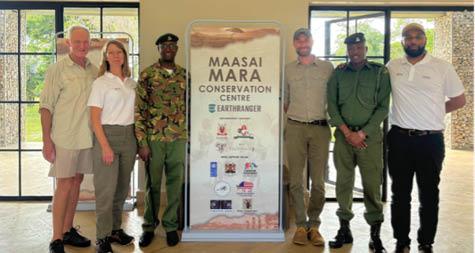06 November 2025

The Maasai Mara National Reserve, a jewel of Kenya’s rich natural heritage, faces mounting pressures from tourism, poaching, and human-wildlife conflicts. In response, The Safari Collection Footprint Trust (TSCFT), in collaboration with the Narok County Government and key technology partners, embarked on an ambitious project to revolutionise conservation through innovative technology solutions — most notably, the deployment of a state-of-the-art LoRaWAN network.
Addressing over-tourism and its ecological toll
In October 2024, a groundbreaking Maasai Mara Conservation Centre was inaugurated, symbolising a new era in ecological stewardship. Developed through a strategic partnership involving TSCFT, 51 Degrees Ltd., Cisco, Actility, and the Connected Conservation Foundation, this facility integrates advanced EarthRanger software with a robust LoRaWAN network — delivering real-time insights into wildlife and tourism activities. This holistic approach empowers authorities to make data-driven decisions, ensuring the long-term sustainability of one of Africa’s most treasured ecosystems.
The Maasai Mara attracts over 300,000 visitors annually, with peak seasons witnessing more than 100 safari vehicles crowding key wildlife hotspots. Such overcrowding disrupts natural behaviours, particularly among sensitive species like cheetahs and predators, leading to decreased reproductive success and altered migration patterns. For instance, research indicates that high vehicle density reduces cheetah cub survival rates dramatically, threatening their long-term viability.
Using LoRa vehicle sensors and live data streams, authorities can monitor vehicle speed, congestion levels, and hotspot activity in real time. These insights facilitate better regulation of tourist flow, deployment of anti-harassment rangers, and promotion of ethical tourism practices — balancing the economic benefits of tourism with ecological preservation.

Innovative wildlife monitoring for vulnerable species
Traditional Maasai pastoralist practices, such as rotational grazing, are vital for sustainable land use and community livelihoods. The conservation centre supports these initiatives by providing ecosystem data that guides community access to grazing areas outside the Reserve. This collaborative approach promotes harmonious coexistence between humans and wildlife, ensuring resource sustainability and reducing conflicts.
The conservation of endangered species like the Eastern black rhino is a top priority. In partnership with Kenya Wildlife Service and local research institutes, TSCFT has equipped 13 rhinos with LoRa sensors — offering a durable, cost-effective alternative to satellite tags. These devices generate detailed movement heat maps, tracking rhino migrations across borders into Tanzania and the Serengeti. Such real-time data enhances anti-poaching efforts and informs transboundary conservation strategies.
A shared vision for the future
The Maasai Mara’s sustainable future hinges on continuous innovation, community engagement, and collaborative stewardship. Supported by a coalition of organisations — including the Connected Conservation Foundation, Fondation Segré, The Mara Conservancy, and the American Rhino Foundation — this initiative exemplifies the transformative power of collective action.
The deployment of the LoRaWAN network at the Maasai Mara Conservation Centre marks a significant stride toward addressing overtourism, safeguarding endangered species, and fostering responsible tourism. By providing actionable data and fostering community involvement, this project sets a precedent for conservation efforts across Africa and beyond — ensuring that the Maasai Mara remains a vibrant sanctuary for generations to come.







